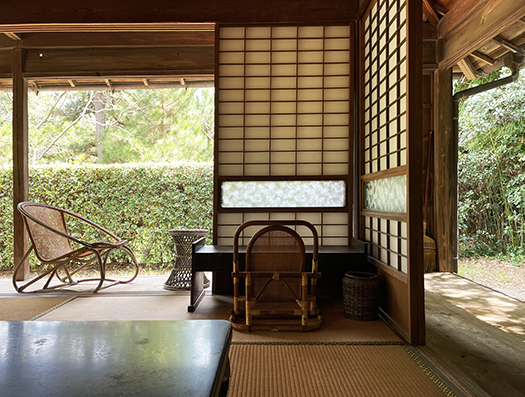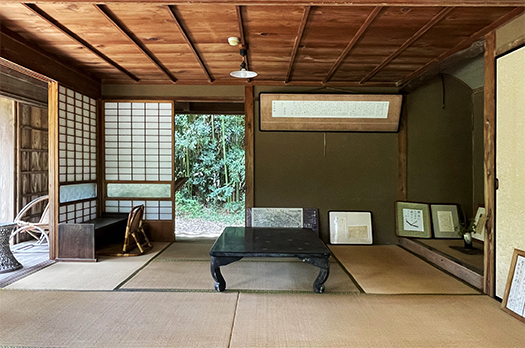

芥川龍之介という作家はわたし個人的に思い入れがあるのかも知れない。イマドキの人にとっては明治大正期の文豪というのはほぼ紫式部、清少納言とも同列の歴史の印象なのでしょうか。
わたし個人的には「羅生門」が好きで、ああいう歴史上のワンシーンをピンナップして、そこに人間の葛藤、その断面を構成するという「作家」性に刺激を受けた世代。それに対して現代感覚ではYou-tube動画などの世界の方がはるかに刺激的なのでしょう。わたし自身も、現代の芥川賞受賞作みたいなものには一切反応しなくなっている。
しかし人間は常に頭のなかに「あたらしい考え」を生み出そうとする創造性をいつの世でも重視してきたのだと思います。資本主義が社会を覆っていって、そういう創造性に対しても「生産性」「効率」ということを追究するようになった。
作家を「缶詰め」にしていい作品を生み出させて、それを文学「商品」として高い付加価値付きで売り抜けようという魂胆が盛り上がっていく。
そのときに作家の創造力・想像力を賦活する空間環境ということを必死に考えたのだろう。この芥川荘の空気の中で、大正期のそういう出版人の狙いというものを無意識で探していた。上の写真2枚は芥川龍之介が向かっていたに違いない「文机」周辺の様子。
現代人はこのような座り机は遠慮したいけれど、大正期の芥川にはこういった姿勢環境のほうが適合的だったのだろう。また、この文机は南西側の角に設置されている。日中の作業としては採光環境をそのように設定している。文机自体は非常にコンパクトであり、ほぼ執筆作業平面だけだと想像できる。たぶん参考文献の類は周辺の畳の上に散乱されたに違いない。
ときどき目を休める周辺環境として、砂防林と生け垣が緑を提供して心身の平安を視覚的に担保していたに違いない。恋文まで書いたのだから、かれの本性を解放できる環境だったのだろう。


この時代人が「こういう環境ならば作家は気持ちよく大量のいい作品を生み出してくれる」と商売っ気満々に提供した空間ということになる。そして事実、芥川は小説作品を生産し、その高揚のままにラブレターまでしたためた。さすがに旅館側はその「生産物」についてもしっかり着目して個人情報などには一切配慮せず、作家に許諾を求めて、碑文まで建造して大々的に一流旅館のシンボルとして活用して,今日、わたしのような人間にまで投網をかけ続けている(笑)。
こういう個人の内面情報まですべてさらけ出すという「習慣」がその後の日本の作家、芥川龍之介から太宰治などの「自死」文化に影を落としているとも暗く思えてくる。
空間それ自体への興味と、その空間性を直接的に商品化する旅館という二重の意味で、まことに興味深い事例だと思われる。
English version⬇
Creativity Productive Space Ryunosuke Akutagawa, The Hermitage of Kujukuri – 6
Capitalism that tries to stimulate the imagination and draw out maximum efficiency in an extraordinary space. A landscape of the first source of Japanese literature that remembers exuberance and produces works of art. …
I may have a personal attachment to the writer Ryunosuke Akutagawa. For the people of today, the great writers of the Meiji and Taisho periods are almost on the same historical level as Murasaki Shikibu and Sei Shonagon, I suppose.
I personally loved “Rashomon,” and I am of the generation that was stimulated by the “writerly” nature of the author’s ability to pin up a scene from history and compose a cross-section of the human conflict. In contrast, the world of You-tube videos is probably much more stimulating in the modern sense. I myself no longer respond to anything like the Akutagawa Prize-winning works of today.
However, I believe that human beings have always valued creativity, which is the attempt to generate “new ideas” in our minds. As capitalism has taken over society, people have come to pursue “productivity” and “efficiency” even in the face of such creativity.
The spirit of “canning” writers to produce good works and then selling them as literary “products” with high added value became more and more popular.
The writers must have been desperate to create a space that would stimulate their creativity and imagination. In the atmosphere of Akutagawa-so, I was subconsciously searching for the aims of such publishers in the Taisho era. The two photos above show the area around the “writing desk” where Ryunosuke Akutagawa must have been sitting.
While modern people would prefer not to sit at a desk like this, Akutagawa would have found this kind of posture more suitable for the Taisho period. The writing desk is located on the southwest corner of the room. The desk is located in the southwest corner of the room, which provides the best lighting for working during the daytime. The writing desk itself is very compact, and it can be imagined that it is almost exclusively used as a writing surface. The references must have been scattered on the tatami mats in the surrounding area.
The erosion control forest and hedges must have provided greenery as a surrounding environment where one could occasionally rest one’s eyes, visually assuring peace of mind and body. It must have been an environment where he could release his true nature, since he even wrote a love letter.
It was a space provided by the people of this era with a commercial mindset that writers would be comfortable in such an environment and produce a large volume of good works. In fact, Akutagawa produced a novel and even wrote a love letter in his exuberance. The ryokan, as one would expect, paid close attention to the “product” and did not give any consideration to personal information, asking permission from the writer and even building an inscription to be used as a symbol of a first-class ryokan, which today continues to cast a net even for people like me (laughs).
It seems dark to me that this “habit” of exposing all information about the inner life of individuals has cast a shadow over the “suicide” culture of subsequent Japanese writers, from Ryunosuke Akutagawa to Osamu Dazai and others.
This is a truly interesting case study in the dual sense of an interest in space itself and the ryokan that directly commodifies that spatiality.
Posted on 10月 11th, 2023 by 三木 奎吾
Filed under: 住宅マーケティング, 日本社会・文化研究







コメントを投稿
「※誹謗中傷や、悪意のある書き込み、営利目的などのコメントを防ぐために、投稿された全てのコメントは一時的に保留されますのでご了承ください。」
You must be logged in to post a comment.